Recent Progress in Source/Drain Ohmic Contact with β-Ga2O3
Abstract
:1. Introduction
2. Basic Metal–Ga2O3 Contact Physical Theory
3. Approaches to Metal–Ga2O3 Ohmic Contact
3.1. Metal Electrode
3.2. Surface Treatment
3.3. Ion Implantation
3.4. Epitaxial Regrowth
3.5. Adding the Interlayer
4. Conclusions
Author Contributions
Funding
Data Availability Statement
Conflicts of Interest
References
- Sonnenberg, T.; Verploegh, S.; Pinto, M.; Popović, Z. W-Band GaN HEMT Frequency Multipliers. IEEE Trans. Microw. Theory Tech. 2023, 71, 4327–4336. [Google Scholar] [CrossRef]
- Akso, E.; Collins, H.; Clymore, C.; Li, W.; Guidry, M.; Romanczyk, B.; Wurm, C.; Liu, W.; Hatui, N.; Hamwey, R.; et al. First Demonstration of Four-Finger N-polar GaN HEMT Exhibiting Record 712 mW Output Power With 31.7% PAE at 94 GHz. IEEE Microw. Wirel. Technol. Lett. 2023, 33, 683–686. [Google Scholar] [CrossRef]
- Han, L.; Tang, X.; Wang, Z.; Gong, W.; Zhai, R.; Jia, Z.; Zhang, W. Research Progress and Development Prospects of Enhanced GaN HEMTs. Crystals 2023, 13, 911. [Google Scholar] [CrossRef]
- Li, H.; Zhao, S.; Wang, X.; Ding, L.; Mantooth, A.H. Parallel Connection of Silicon Carbide MOSFETs Challenges, Mechanism, and Solutions. IEEE Trans. Power Electron. 2023, 38, 9731–9749. [Google Scholar] [CrossRef]
- Lyu, G.; Sun, J.; Wei, J.; Chen, K.J. Static and Dynamic Characteristics of a 1200 V/22 mΩ Normally-Off SiC/GaN Cascode Device Built with Parallel-Connected SiC JFETs Controlled by a Single GaN HEMT. IEEE Trans. Power Electron. 2023, 38, 12648–12658. [Google Scholar] [CrossRef]
- Roy, R.; Hill, V.G.; Osborn, E.F. Polymorphism of Ga2O3 and the system Ga2O3-H2O. J. Am. Chem. Soc. 1952, 74, 719–722. [Google Scholar] [CrossRef]
- Yoshioka, S.; Hayashi, H.; Kuwabara, A.; Oba, F.; Matsunaga, K.; Tanaka, I. Structures and energetics of Ga2O3 polymorphs. J. Phys. Condens. Matter 2007, 19, 346211. [Google Scholar] [CrossRef]
- Bechstedt, F.; Furthmüller, J. Influence of screening dynamics on excitons in Ga2O3 polymorphs. Appl. Phys. Lett. 2019, 114, 122101. [Google Scholar] [CrossRef]
- Pearton, S.J.; Yang, J.; Cary, P.H.; Ren, F.; Kim, J.; Tadjer, M.J.; Mastro, M.A. A review of Ga2O3 materials, processing, and devices. Appl. Phys. Rev. 2018, 5, 011301. [Google Scholar] [CrossRef]
- Wang, C.; Zhang, J.; Xu, S.; Zhang, C.; Feng, Q.; Zhang, Y.; Ning, J.; Zhao, S.; Zhou, H.; Hao, Y. Progress in state-of-the-art technologies of Ga2O3 devices. J. Phys. D Appl. Phys. 2021, 54, 243001. [Google Scholar] [CrossRef]
- Sheoran, H.; Kumar, V.; Singh, R. A comprehensive review on recent developments in ohmic and Schottky contacts on Ga2O3 for device applications. ACS Appl. Electron. Mater. 2022, 4, 2589–2628. [Google Scholar] [CrossRef]
- Abedi Rik, N.; Orouji, A.A.; Madadi, D. 500 V breakdown voltage in β-Ga2O3 laterally diffused metal-oxide-semiconductor field-effect transistor with 108 MW/cm2 power figure of merit. IET Circuits Devices Syst. 2023, 17, 199–204. [Google Scholar] [CrossRef]
- Wang, X.; Lu, X.; He, Y.; Liu, P.; Shao, Y.; Li, J.; Yang, Y.; Li, Y.; Hao, Y.; Ma, X. An E-mode β-Ga2O3 metal-heterojunction composite field effect transistor with a record high P-FOM of 0.73 GW/cm2. In Proceedings of the 2023 35th International Symposium on Power Semiconductor Devices and ICs (ISPSD), Hong Kong, 28 May–1 June 2023; pp. 390–393. [Google Scholar] [CrossRef]
- Liu, H.; Wang, Y.; Lv, Y.; Han, S.; Han, T.; Dun, S.; Guo, H.; Bu, A.; Feng, Z. 10-kV Lateral β-Ga2O3 MESFETs with B ion Implanted Planar Isolation. IEEE Electron. Device Lett. 2023, 44, 1048–1051. [Google Scholar] [CrossRef]
- Guo, W.; Han, Z.; Zhao, X.; Xu, G.; Long, S. Large-area β-Ga2O3 Schottky barrier diode and its application in DC-DC converters. J. Semicond. 2023, 44, 072805. [Google Scholar] [CrossRef]
- Wei, Y.; Peng, X.; Jiang, Z.; Sun, T.; Wei, J.; Yang, K.; Hao, L.; Luo, X. Low Reverse Conduction Loss β-Ga2O3 Vertical FinFET with an Integrated Fin Diode. IEEE Trans. Electron. Devices 2023, 70, 3454–3461. [Google Scholar] [CrossRef]
- Hao, W.; Wu, F.; Li, W.; Xu, G.; Xie, X.; Zhou, K.; Guo, W.; Zhou, X.; He, Q.; Zhao, X.; et al. Improved Vertical β-Ga2O3 Schottky Barrier Diodes with Conductivity-Modulated p-NiO Junction Termination Extension. IEEE Trans. Electron. Devices 2023, 70, 2129–2134. [Google Scholar] [CrossRef]
- Wu, F.; Wang, Y.; Jian, G.; Xu, G.; Zhou, X.; Guo, W.; Du, J.; Liu, Q.; Dun, S.; Yu, Z.; et al. Superior Performance β-Ga2O3 Junction Barrier Schottky Diodes Implementing p-NiO Heterojuntion and Beveled Field Plate for Hybrid Cockcroft–Walton Voltage Multiplier. IEEE Trans. Electron. Devices 2023, 70, 1199–1205. [Google Scholar] [CrossRef]
- Zhang, C.; Liu, K.; Ai, Q.; Sun, X.; Chen, X.; Yang, J.; Zhu, Y.; Cheng, Z.; Li, B.; Liu, L.; et al. High-performance fully transparent Ga2O3 solar-blind UV photodetector with the embedded indium-tin-oxide electrodes. Mater. Today Phys. 2023, 33, 101034. [Google Scholar] [CrossRef]
- Li, Y.; Deng, C.; Huang, B.; Yang, S.; Xu, J.; Zhang, G.; Hu, S.; Wang, D.; Liu, B.; Ji, Z.; et al. High-Performance Solar-Blind UV Phototransistors Based on ZnO/Ga2O3 Heterojunction Channels. ACS Appl. Mater. Interfaces 2023, 15, 18372–18378. [Google Scholar] [CrossRef]
- Zeng, G.; Zhang, M.R.; Chen, Y.C.; Li, X.; Chen, D.; Shi, C.; Zhao, X.; Chen, N.; Wang, T.; Zhang, W.; et al. A solar-blind photodetector with ultrahigh rectification ratio and photoresponsivity based on the MoTe2/Ta: β-Ga2O3 pn junction. Mater. Today Phys. 2023, 33, 101042. [Google Scholar] [CrossRef]
- Matys, M.; Kitagawa, K.; Narita, T.; Uesugi, T.; Suda, J.; Kachi, T. Mg-implanted vertical GaN junction barrier Schottky rectifiers with low on resistance, low turn-on voltage, and nearly ideal nondestructive breakdown voltage. Appl. Phys. Lett. 2022, 121, 203507. [Google Scholar] [CrossRef]
- Aida, H.; Nishiguchi, K.; Takeda, H.; Aota, N.; Sunakawa, K.; Yaguchi, Y. Growth of β-Ga2O3 single crystals by the edge-defined, film fed growth method. Jpn. J. Appl. Phys. 2008, 47, 8506. [Google Scholar] [CrossRef]
- Ohira, S.; Suzuki, N.; Arai, N.; Tanaka, M.; Sugawara, T.; Nakajima, K.; Shishido, T. Characterization of transparent and conducting Sn-doped β-Ga2O3 single crystal after annealing. Thin Solid Film. 2008, 516, 5763–5767. [Google Scholar] [CrossRef]
- Víllora, E.G.; Shimamura, K.; Yoshikawa, Y.; Aoki, K.; Ichinose, N. Large-size β-Ga2O3 single crystals and wafers. J. Cryst. Growth 2004, 270, 420–426. [Google Scholar] [CrossRef]
- Hoshikawa, K.; Ohba, E.; Kobayashi, T.; Yanagisawa, J.; Miyagawa, C.; Nakamura, Y. Growth of β-Ga2O3 single crystals using vertical Bridgman method in ambient air. J. Cryst. Growth 2016, 447, 36–41. [Google Scholar] [CrossRef]
- Nikolaev, V.I.; Maslov, V.; Stepanov, S.I.; Pechnikov, A.I.; Krymov, V.; Nikitina, I.P.; Guzilova, L.I.; Bougrov, V.E.; Romanov, A.E. Growth and characterization of β-Ga2O3 crystals. J. Cryst. Growth 2017, 457, 132–136. [Google Scholar] [CrossRef]
- Tomm, Y.; Reiche, P.; Klimm, D.; Fukuda, T. Czochralski grown Ga2O3 crystals. J. Cryst. Growth 2000, 220, 510–514. [Google Scholar] [CrossRef]
- Galazka, Z.; Uecker, R.; Irmscher, K.; Albrecht, M.; Klimm, D.; Pietsch, M.; Brützam, M.; Bertram, R.; Ganschow, S.; Fornari, R. Czochralski growth and characterization of β-Ga2O3 single crystals. Cryst. Res. Technol. 2010, 45, 1229–1236. [Google Scholar] [CrossRef]
- Alema, F.; Seryogin, G.; Osinsky, A.; Osinsky, A. Ge doping of β-Ga2O3 by MOCVD. APL Mater. 2021, 9, 091102. [Google Scholar] [CrossRef]
- Seryogin, G.; Alema, F.; Valente, N.; Fu, H.; Steinbrunner, E.; Neal, A.; Mou, S.; Fine, A.; Osinsky, A. MOCVD growth of high purity Ga2O3 epitaxial films using trimethylgallium precursor. Appl. Phys. Lett. 2020, 117, 262101. [Google Scholar] [CrossRef]
- Xia, Z.; Joishi, C.; Krishnamoorthy, S.; Bajaj, S.; Zhang, Y.; Brenner, M.; Lodha, S.; Rajan, S. Delta Doped β-Ga2O3 Field Effect Transistors with Regrown Ohmic Contacts. IEEE Electron. Device Lett. 2018, 39, 568–571. [Google Scholar] [CrossRef]
- Krishnamoorthy, S.; Xia, Z.; Bajaj, S.; Brenner, M.; Rajan, S. Delta-doped β-gallium oxide field-effect transistor. Appl. Phys. Express 2017, 10, 051102. [Google Scholar] [CrossRef]
- Oshima, Y.; Víllora, E.G.; Shimamura, K. Halide vapor phase epitaxy of twin-free α-Ga2O3 on sapphire (0001) substrates. Appl. Phys. Express 2015, 8, 055501. [Google Scholar] [CrossRef]
- Murakami, H.; Nomura, K.; Goto, K.; Sasaki, K.; Kawara, K.; Thieu, Q.; Togashi, R.; Kumagai, Y.; Higashiwaki, M.; Kuramata, A.; et al. Homoepitaxial growth of β-Ga2O3 layers by halide vapor phase epitaxy. Appl. Phys. Express 2014, 8, 015503. [Google Scholar] [CrossRef]
- Bhattacharyya, A.; Roy, S.; Ranga, P.; Shoemaker, D.; Song, Y.; Lundh, J.; Choi, S.; Krishnamoorthy, S. 130 mA mm−1 β-Ga2O3 metal semiconductor field effect transistor with low-temperature metalorganic vapor phase epitaxy-regrown ohmic contacts. Appl. Phys. Express 2021, 14, 076502. [Google Scholar] [CrossRef]
- Liddy, K.J.; Green, A.; Hendricks, N.; Heller, E.; Moser, N.; Leedy, K.; Popp, A.; Lindquist, M.; Tetlak, S.; Wagner, G.; et al. Thin channel β-Ga2O3 MOSFETs with self-aligned refractory metal gates. Appl. Phys. Express 2019, 12, 126501. [Google Scholar] [CrossRef]
- Varley, J.B.; Janotti, A.; Franchini, C.; Walle, C. Role of self-trap in luminescence and p-type conductivity of wide-band-gap oxides. Phys. Rev. B 2012, 85, 081109. [Google Scholar] [CrossRef]
- Lyons, J.L. A survey of acceptor dopants for β-Ga2O3. Semicond. Sci. Technol. 2018, 33, 05LT02. [Google Scholar] [CrossRef]
- Gallagher, J.C.; Koehler, A.D.; Tadjer, M.J.; Mahadik, A.; Anderson, T.; Budhathoki, S.; Law, K.; Hauser, A.; Hobart, K.; Kub, F. Demonstration of Cul as a P-N heterojunction to β-Ga2O3. Appl. Phys. Express 2019, 12, 104005. [Google Scholar] [CrossRef]
- Budde, M.; Splith, D.; Mazzolini, P.; Tahraoui, A.; Feld, J.; Ramsteiner, M.; Wenckstern, H.; Grundmann, M.; Bierwage, O. SnO/β-Ga2O3 vertical pn heterojunction diodes. Appl. Phys. Lett. 2020, 117, 252106. [Google Scholar] [CrossRef]
- Watahiki, T.; Yuda, Y.; Furukawa, A.; Yamamuka, M.; Takiguchi, Y.; Miyajima, S. Heterojunction p-Cu2O/n-Ga2O3 diode with high breakdown voltage. Appl. Phys. Lett. 2017, 111, 222104. [Google Scholar] [CrossRef]
- Lu, X.; Zhou, X.; Jiang, H.; Ng, K.; Chen, Z.; Pei, Y.; Lau, K.; Wang, G. 1-kV Sputtered p-NiO/n-Ga2O3 Heterojunction Diodes With an Ultra-Low Leakage Current Below 1μA/cm2. IEEE Electron. Device Lett. 2020, 41, 449–452. [Google Scholar] [CrossRef]
- Wang, Y.G.; Gong, H.H.; Lv, Y.J.; Fu, X.; Dun, S.; Han, T.; Liu, H.; Zhou, X.; Liang, S.; Zhang, R.; et al. 2.41 kV vertical P-NiO/n-Ga2O3 heterojunction diodes with a record Baliga’s figure-of-merit of 5.18 GW/cm2. IEEE Trans Power Electron. 2022, 37, 3743. [Google Scholar] [CrossRef]
- Nakagomi, S.; Hiratsuka, K.; Kakuda, Y.; Yoshihiro, K. Beta-gallium oxide/SiC heterojunction diodes with high rectification ratios. ECS J. Solid State Sci. Technol. 2016, 6, Q3030. [Google Scholar] [CrossRef]
- Zhang, Y.C.; Li, Y.F.; Wang, Z.Z.; Guo, R.; Xu, S.; Liu, C.; Zhao, S.; Zhang, J.; Hao, Y. Investigation of β-Ga2O3 films and β-Ga2O3/GaN heterostructures grown by metal organic chemical vapor deposition. Sci. China Phys. Mech. Astron. 2020, 63, 117311. [Google Scholar] [CrossRef]
- Jaquez, M.; Specht, P.; Yu, K.M.; Walukiewicz, W.; Dubon, D. Amorphous gallium oxide sulfide: A highly mismatched alloy. J. Appl. Phys. 2019, 126, 105708. [Google Scholar] [CrossRef]
- Cai, X.; Sabino, F.P.; Janotti, A.; Wei, S. Approach to achieving a p-type transparent conducting oxide: Doping of bismuth-alloyed Ga2O3 with a strongly correlated band edge state. Phys. Rev. B 2021, 103, 115205. [Google Scholar] [CrossRef]
- Kaneko, K.; Masuda, Y.; Kan, S.; Takahashi, I.; Kato, Y.; Shinohe, T.; Fujita, S. Ultra-wide bandgap corundum-structured p-type α-(Ir, Ga) 2O3 alloys for α-Ga2O3 electronics. Appl. Phys. Lett. 2021, 118, 102104. [Google Scholar] [CrossRef]
- Li, Z.H.; Egbo, K.O.; Lv, X.H.; Wang, Y.; Yu, K. Electronic structure and properties of Cu2-xS thin films: Dependence of phase structures and free-hole concentrations. Appl. Surf. Sci. 2022, 572, 151530. [Google Scholar] [CrossRef]
- Ezeh, C.V.; Egbo, K.O.; Musah, J.D.; Yu, K.M. Wide gap p-type NiO-Ga2O3 alloy via electronic band engineering. J. Alloys Compd. 2023, 932, 167275. [Google Scholar] [CrossRef]
- Fan, M.Y.; Yang, G.Y.; Zhou, G.N.; Jiang, Y.; Li, W.; Jiang, Y.; Yu, H. Ultra-low Contact Resistivity of< 0.1 Ω mm for Au-free TixAly Alloy Contact on Non-recessed i-AlGaN/GaN. IEEE Electron. Device Lett. 2020, 41, 143–146. [Google Scholar] [CrossRef]
- Zhang, J.; Kang, X.; Wang, X.; Huang, S.; Chen, C.; Kei, K.; Zheng, Y.; Zhou, Q.; Chen, W.; Zhang, B.; et al. Ultralow-Contact-Resistance Au-Free Ohmic Contacts With Low Annealing Temperature on AlGaN/GaN Heterostructures. IEEE Electron. Device Lett. 2018, 39, 847–850. [Google Scholar] [CrossRef]
- Xu, R.; Lin, N.; Jia, Z.; Liu, Y.; Wang, H.; Yu, Y.; Zhao, X. First principles study of Schottky barriers at Ga2O3(100)/metal interfaces. RSC Adv. 2020, 10, 14746–14752. [Google Scholar] [CrossRef] [PubMed]
- Lovejoy, T.C.; Chen, R.; Zheng, X.; Villora, E.; Shimamura, K.; Yoshikawa, H.; Yamashita, Y.; Ueda, S.; Kobayashi, K.; Dunham, S.; et al. Band bending and surface defects in β-Ga2O3. Appl. Phys. Lett. 2012, 100, 181602. [Google Scholar] [CrossRef]
- Yao, Y.; Gangireddy, R.; Kim, J.; Das, K.; Davis, R.; Porter, L. Electrical behavior of β-Ga2O3 Schottky diodes with different Schottky metals. J. Vac. Sci. Technol. B 2017, 35, 03D113. [Google Scholar] [CrossRef]
- Mott, N.F. Note on the contact between a metal and an insulator or semi-conductor. In Mathematical Proceedings of the Cambridge Philosophical Society; Cambridge University Press: Cambridge, UK, 1938; pp. 568–572. [Google Scholar]
- Sze, S.M.; Ng, K.K. Physics of Semiconductor Devices; John Wiley & Sons: Hoboken, NJ, USA, 2006. [Google Scholar]
- Neamen, D. Semiconductor Physics and Devices; McGraw-Hill, Inc.: New York, NY, USA, 2002. [Google Scholar]
- Mohamed, M.; Irmscher, K.; Janowitz, C.; Galazka, Z.; Manzke, R.; Fornari, R. Schottky barrier height of Au on the transparent semiconducting oxide β-Ga2O3. Appl. Phys. Lett. 2012, 101, 132106. [Google Scholar] [CrossRef]
- Sze, S.M. Physics of Semiconductor Devices, 2nd ed.; Wily: New York, NY, USA, 1982. [Google Scholar]
- Rideout, V.L. A review of the theory and technology for ohmic contacts to group III-V compound semiconductors. Solid-State Electron. 1975, 18, 541–550. [Google Scholar] [CrossRef]
- Reeves, G.K.; Harrison, H.B. Obtaining the specific contact resistance from transmission line model measurements. IEEE Electron. Device Lett. 1982, 3, 111–113. [Google Scholar] [CrossRef]
- Schroder, D.K. Contact Resistance and Schottky Barriers; Wiley: New York, NY, USA, 2006. [Google Scholar]
- Yao, Y.; Davis, R.F.; Porter, L.M. Investigation of different metals as ohmic contacts to β-Ga2O3: Comparison and analysis of electrical behavior, morphology, and other physical properties. J. Electron. Mater. 2017, 46, 2053–2060. [Google Scholar] [CrossRef]
- Shi, J.; Xia, X.; Liang, H.; Abbas, Q.; Liu, J.; Zhang, H.; Liu, Y. Low resistivity ohmic contacts on lightly doped n-type β-Ga2O3 using Mg/Au. J. Mater. Sci. Mater. Electron. 2019, 30, 3860–3864. [Google Scholar] [CrossRef]
- Ma, J.; Yoo, G. Low Subthreshold Swing Double-Gate β-Ga2O3 Field-Effect Transistors with Polycrystalline Hafnium Oxide Dielectrics. IEEE Electron. Device Lett. 2019, 40, 1317–1320. [Google Scholar] [CrossRef]
- Lee, M.-H.; Peterson, R.L. Interfacial reactions of titanium/gold ohmic contacts with Sn-doped β-Ga2O3. APL Mater. 2019, 7, 022524. [Google Scholar] [CrossRef]
- Higashiwaki, M.; Sasaki, K.; Kamimura, T.; Wong, M.; Krishnamurthy, D.; Kuramata, A.; Masui, T.; Yamakoshi, S. Depletion-mode Ga2O3 metal-oxide-semiconductor field-effect transistors on β-Ga2O3 (010) substrates and temperature dependence of their device characteristics. Appl. Phys. Lett. 2013, 103, 123511. [Google Scholar] [CrossRef]
- Zhou, H.; Si, M.; Alghamdi, S.; Qiu, G.; Yang, L.; Ye, P. High-Performance Depletion/Enhancement-mode β-Ga2O3 on Insulator (GOOI) Field-Effect Transistors with Record Drain Currents of 600/450 mA/mm. IEEE Electron. Device Lett. 2016, 38, 103–106. [Google Scholar] [CrossRef]
- Zhou, H.; Maize, K.; Qiu, G.; Shakouri, A.; Ye, P. β-Ga2O3 on insulator field-effect transistors with drain currents exceeding 1.5 A/mm and their self-heating effect. Appl. Phys. Lett. 2017, 111, 092102. [Google Scholar] [CrossRef]
- Chabak, K.D.; Moser, N.; Green, A.; Jr, D.; Tetlak, S.; Heller, E.; Crespo, A.; Fitch, R.; McCandless, J.; Leedy, K.; et al. Enhancement-mode Ga2O3 wrap-gate fin field-effect transistors on native (100) β-Ga2O3 substrate with high breakdown voltage. Appl. Phys. Lett. 2016, 109, 213501. [Google Scholar] [CrossRef]
- Chen, J.; Li, X.; Ma, H.; Huang, W.; Ji, Z.; Xia, C.; Lu, H.; Zhang, W. Investigation of the mechanism for Ohmic contact formation in Ti/Al/Ni/Au contacts to β-Ga2O3 nanobelt field-effect transistors. ACS Appl. Mater. Interfaces 2019, 11, 32127–32134. [Google Scholar] [CrossRef]
- Gong, R.; Wang, J.; Liu, S.; Dong, Z.; Yu, M.; Wen, C.; Cai, Y.; Zhang, B. Analysis of surface roughness in Ti/Al/Ni/Au ohmic contact to AlGaN/GaN high electron mobility transistors. Appl. Phys. Lett. 2010, 97, 062115. [Google Scholar] [CrossRef]
- Fontserè, A.; Tomás, A.; Placidi, M.; Llobet, J.; Baron, N.; Chenot, S.; Cordier, Y.; Moreno, J.; Gammon, P.; Jennings, M.; et al. Micro and nano analysis of 0.2 Ω mm Ti/Al/Ni/Au ohmic contact to AlGaN/GaN. Appl. Phys. Lett. 2011, 99, 213504. [Google Scholar] [CrossRef]
- Tetzner, K.; Schewski, R.; Popp, A.; Anooz, S.; Chou, T.; Ostermay, I.; Kirmse, H.; Würfl, J. Refractory metal-based ohmic contacts on β-Ga2O3 using TiW. APL Mater. 2022, 10, 071108. [Google Scholar] [CrossRef]
- Lee, M.H.; Chou, T.S.; Bin Anooz, S.; Galazka, Z.; Popp, A.; Peterson, R. Effect of post-metallization anneal on (100) Ga2O3/Ti-Au ohmic contact performance and interfacial degradation. APL Mater. 2022, 10, 091105. [Google Scholar] [CrossRef]
- Kim, Y.; Kim, M.K.; Baik, K.H.; Jang, S. Low-resistance Ti/Au ohmic contact on (001) plane Ga2O3 Crystal. ECS J. Solid State Sci. Technol. 2022, 11, 045003. [Google Scholar] [CrossRef]
- Porter, L.M.; Hajzus, J.R. Perspectives from research on metal-semiconductor contacts: Examples from Ga2O3, SiC, (nano) diamond, and SnS. J. Vac. Sci. Technol. A 2020, 38, 031005. [Google Scholar] [CrossRef]
- Lyle, L.A.M.; Back, T.C.; Bowers, C.T.; Green, A.; Chabak, K.; Dorsey, D.; Heller, E.; Porter, L.M. Electrical and chemical analysis of Ti/Au contacts to β-Ga2O3. APL Mater. 2021, 9, 061104. [Google Scholar] [CrossRef]
- Guo, D.Y.; Wu, Z.P.; An, Y.H.; Guo, X.C.; Chu, X.L.; Sun, C.L.; Li, L.H.; Li, P.G.; Tang, W.H. Oxygen vacancy tuned Ohmic-Schottky conversion for enhanced performance in β-Ga2O3 solar-blind ultraviolet photodetectors. Appl. Phys. Lett. 2014, 105, 023507. [Google Scholar] [CrossRef]
- Higashiwaki, M.; Sasaki, K.; Kuramata, A.; Masui, T.; Yamakoshi, S. Gallium oxide (Ga2O3) metal-semiconductor field-effect transistors on single-crystal β-Ga2O3 (010) substrates. Appl. Phys. Lett. 2012, 100, 013504. [Google Scholar] [CrossRef]
- Sasaki, K.; Higashiwaki, M.; Kuramata, A.; Masui, T.; Yamakoshi, S. Si-ion implantation doping in β-Ga2O3 and its application to fabrication of low-resistance ohmic contacts. Appl. Phys. Express 2013, 6, 086502. [Google Scholar] [CrossRef]
- Oshima, T.; Okuno, T.; Arai, N.; Suzuki, N.; Ohira, S.; Fujita, S. Vertical solar-blind deep-ultraviolet Schottky photodetectors based on β-Ga2O3 substrates. Appl. Phys. Express 2008, 1, 011202. [Google Scholar] [CrossRef]
- Wong, M.H.; Sasaki, K.; Kuramata, A.; Yamakoshi, S.; Higashiwaki, M. Field-plated Ga2O3 MOSFETs with a breakdown voltage of over 750 V. IEEE Electron. Device Lett. 2015, 37, 212–215. [Google Scholar] [CrossRef]
- Higashiwaki, M.; Kuramata, A.; Murakami, H.; Kumagai, Y. State-of-the-art technologies of gallium oxide power devices. J. Phys. D Appl. Phys. 2017, 50, 333002. [Google Scholar] [CrossRef]
- Bae, J.; Kim, H.Y.; Kim, J. Contacting mechanically exfoliated β-Ga2O3 nanobelts for (opto) electronic device applications. ECS J. Solid State Sci. Technol. 2016, 6, Q3045. [Google Scholar] [CrossRef]
- Li, Z.; Liu, Y.; Zhang, A.; Liu, Q.; Shen, C.; Wu, F.; Xu, C.; Chen, M.; Fu, H.; Zhou, C. Quasi-two-dimensional β-Ga2O3 field effect transistors with large drain current density and low contact resistance via controlled formation of interfacial oxygen vacancies. Nano Res. 2019, 12, 143–148. [Google Scholar] [CrossRef]
- Spencer, J.A.; Tadjer, M.J.; Jacobs, A.G.; Mastro, M.A.; Lyons, J.L.; Freitas, J.A., Jr.; Gallagher, J.C.; Thieu, Q.T.; Sasaki, K.; Kuramata, A.; et al. Activation of implanted Si, Ge, and Sn donors in high-resistivity halide vapor phase epitaxial β-Ga2O3: N with high mobility. Appl. Phys. Lett 2022, 121, 192102. [Google Scholar] [CrossRef]
- Tetzner, K.; Thies, A.; Seyidov, P.; Chou, T.; Rehm, J.; Ostermay, J.; Galazka, Z.; Fiedler, A.; Popp, A.; Würfl, J. Ge-ion implantation and activation in (100) β-Ga2O3 for ohmic contact improvement using pulsed rapid thermal annealing. J. Vac. Sci. Technol. A 2023, 41, 043102. [Google Scholar] [CrossRef]
- Tadjer, M.; Lyons, J.; Nepal, N.; Freitas, J.A., Jr.; Koehler, A.; Foster, G. Review-Theory and characterization of doping and defects in β-Ga2O3. ECS J. Solid State Sci. Technol. 2019, 8, Q3187–Q3194. [Google Scholar] [CrossRef]
- Nikolskaya, A.; Okulich, E.; Korolev, D.; Stepanov, A.; Nikolichev, D.; Mikhaylov, A.; Tetelbaum, D.; Almaev, A.; Bolzan, C.A.; Buaczik, A., Jr.; et al. Ion implantation in β-Ga2O3: Physics and technology. J. Vac. Sci. Technol. A 2021, 39, 030802. [Google Scholar] [CrossRef]
- Huang, H.L.; Chae, C.; Johnson, J.M.; Senckowski, A.; Sharma, S.; Singisetti, U.; Wong, M.; Hwang, J. Atomic scale defect formation and phase transformation in Si implanted β-Ga2O3. APL Mater. 2023, 11, 061113. [Google Scholar] [CrossRef]
- Lee, M.H.; Chou, T.S.; Bin Anooz, S.; Galazka, Z.; Popp, A.; Peterson, R. Exploiting the nanostructural anisotropy of β-Ga2O3 to demonstrate giant improvement in titanium/gold ohmic contacts. ACS Nano 2022, 16, 11988–11997. [Google Scholar] [CrossRef]
- Zeng, K.; Wallace, J.S.; Heimburger, C.; Sasaki, K.; Kuramata, A.; Masui, T.; Gardella, J.; Singisetti, U. Ga2O3 MOSFETs using spin-on-glass source/drain doping technology. IEEE Electron. Device Lett. 2017, 38, 513–516. [Google Scholar] [CrossRef]
- Alema, F.; Peterson, C.; Bhattacharyya, A.; Roy, S.; Krishnamoorthy, S.; Osinsky, A. Low resistance Ohmic contact on epitaxial MOVPE grown β-Ga2O3 and β-(AlxGa1-x)2O3 films. IEEE Electron. Device Lett. 2022, 43, 1649–1652. [Google Scholar] [CrossRef]
- Lee, M.H.; Peterson, R.L. Process and characterization of ohmic contacts for beta-phase gallium oxide. J. Mater. Res. 2021, 36, 4771–4789. [Google Scholar] [CrossRef]
- Kim, H. Control and understanding of metal contacts to β-Ga2O3 single crystals: A review. SN Appl. Sci. 2022, 4, 27. [Google Scholar] [CrossRef]
- Oshima, T.; Wakabayashi, R.; Hattori, M.; Hashiguchi, A.; Kawano, N.; Sasaki, K.; Masui, T.; Kuramata, A.; Yamakoshi, S.; Yoshimatsu, K. Formation of indium-tin oxide ohmic contacts for β-Ga2O3. Jpn. J. Appl. Phys. 2016, 55, 1202B7. [Google Scholar] [CrossRef]
- Carey, P.H.; Yang, J.; Ren, F.; Hays, D.; Pearton, S.; Kuramata, A.; Kravchenko, I. Improvement of Ohmic contacts on Ga2O3 through use of ITO-interlayers. J. Vac. Sci. Technol. B 2017, 35, 061201. [Google Scholar] [CrossRef]
- Carey, P.H.; Yang, J.; Ren, F.; Hays, D.; Pearton, S.; Jang, S.; Kuramata, A.; Kravchenko, I. Ohmic contacts on n-type β-Ga2O3 using AZO/Ti/Au. AIP Adv. 2017, 7, 095313. [Google Scholar] [CrossRef]
- Carey IVP, H.; Ren, F.; Hays, D.C.; Gila, B.; Pearton, S.; Jang, S.; Kuramata, A. Band offsets in ITO/Ga2O3 heterostructures. Appl. Surf. Sci. 2017, 422, 179–183. [Google Scholar] [CrossRef]
- Carey IVP, H.; Ren, F.; Hays, D.C.; Gila, B.; Pearton, S.; Jang, S.; Kuramata, A. Valence and conduction band offsets in AZO/Ga2O3 heterostructures. Vacuum 2017, 141, 103–108. [Google Scholar] [CrossRef]
- Kim, S.; Kim, S.J.; Kim, K.H.; Kim, H.; Kim, T. Improved performance of Ga2O3/ITO-based transparent conductive oxide films using hydrogen annealing for near-ultraviolet light-emitting diodes. Phys. Status Solidi A 2014, 211, 2569–2573. [Google Scholar] [CrossRef]
- Sui, Y.; Liang, H.; Chen, Q.; Huo, W.; Du, X.; Mei, Z. Room-temperature ozone sensing capability of IGZO-decorated amorphous Ga2O3 films. ACS Appl. Mater. Interfaces 2020, 12, 8929–8934. [Google Scholar] [CrossRef]
- Deng, Y.; Yang, Z.; Xu, T.; Jiang, H.; Ng, K.; Liao, C.; Su, D.; Pei, Y.; Chen, Z.; Wang, G. Band alignment and electrical properties of NiO/β-Ga2O3 heterojunctions with different β-Ga2O3 orientations. Appl. Surf. Sci. 2023, 622, 156917. [Google Scholar] [CrossRef]
- Ingebrigtsen, M.E.; Vines, L.; Alfieri, G. Bulk β-Ga2O3 with (010) and (201) surface orientation: Schottky contacts and point defects. Mater. Sci. Forum 2017, 897, 755–758. [Google Scholar] [CrossRef]
- Yatskiv, R.; Tiagulskyi, S.; Grym, J. Influence of crystallographic orientation on Schottky barrier formation in gallium oxide. J. Electron. Mater. 2020, 49, 5133–5137. [Google Scholar] [CrossRef]
- Wong, M.H.; Nakata, Y.; Kuramata, A.; Yamakoshi, S.; Higashiwaki, M. Enhancement-mode Ga2O3 MOSFETs with Si-ion-implanted source and drain. Appl. Phys. Express 2017, 10, 041101. [Google Scholar] [CrossRef]
- Downey, B.P.; Mohney, S.E.; Clark, T.E.; Flemish, J. Reliability of aluminum-bearing ohmic contacts to SiC under high current density. MicroElectron. Reliab. 2010, 50, 1967–1972. [Google Scholar] [CrossRef]
- Liu, L.; Ling, M.; Yang, J.; Xiong, W.; Jia, W.; Wang, G. Efficiency degradation behaviors of current/thermal co-stressed GaN-based blue light emitting diodes with vertical-structure. J. Appl. Phys. 2012, 111, 093110. [Google Scholar] [CrossRef]
- Moens, P.; Banerjee, A.; Constant, A.; Coppens, P.; Caesar, M.; Li, Z.; Vandeweghe, W.; Declercq, F.; Padmanabhan, B.; Jeon, W. Intrinsic reliability assessment of 650V rated AlGaN/GaN based power devices: An industry perspective. ECS Trans. 2016, 72, 65. [Google Scholar] [CrossRef]
- Li, Y.; Ng, G.I.; Arulkumaran, S.; Kumar, C.; Ang, K.; Anand, M.; Wang, H.; Hofstetter, R.; Ye, G. Low-contact-resistance non-gold Ta/Si/Ti/Al/Ni/Ta Ohmic contacts on undoped AlGaN/GaN high-electron-mobility transistors grown on silicon. Appl. Phys. Express 2013, 6, 116501. [Google Scholar] [CrossRef]
- Piazza, M.; Dua, C.; Oualli, M.; Morvan, E.; Carisetti, D.; Wyczisk, F. Degradation of TiAlNiAu as ohmic contact metal for GaN HEMTs. MicroElectron. Reliab. 2009, 49, 1222–1225. [Google Scholar] [CrossRef]
- Jeong, Y.J.; Yang, J.Y.; Lee, C.H.; Park, R.; Lee, G.; Chung, R.; Yoo, G. Fluorine-based plasma treatment for hetero-epitaxial β-Ga2O3 MOSFETs. Appl. Surf. Sci. 2021, 558, 149936. [Google Scholar] [CrossRef]
- Zhang, L.Q.; Shi, J.S.; Huang, H.F.; Liu, X.; Zhao, S.; Wang, P.; Zhang, W. Low-temperature Ohmic contact formation in GaN high electron mobility transistors using microwave annealing. IEEE Electron. Device Lett. 2015, 36, 896–898. [Google Scholar] [CrossRef]
- Hou, M.; Xie, G.; Sheng, K. Improved device performance in AlGaN/GaN HEMT by forming ohmic contact with laser annealing. IEEE Electron. Device Lett. 2018, 39, 1137–1140. [Google Scholar] [CrossRef]


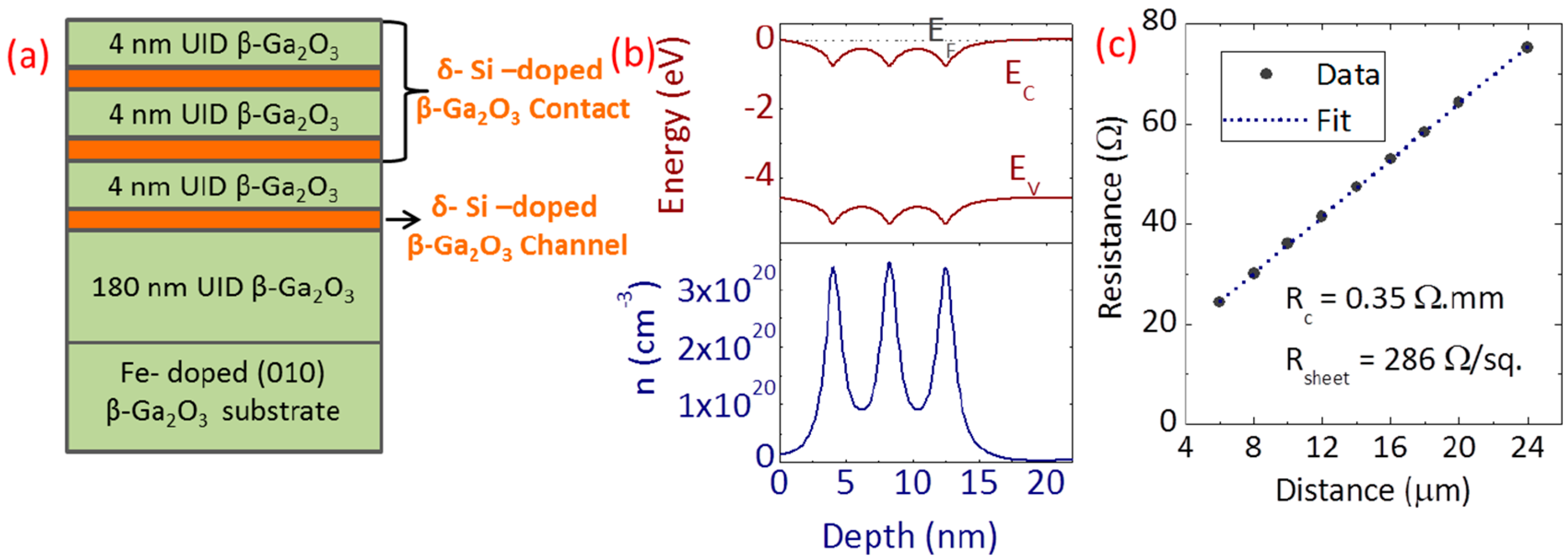




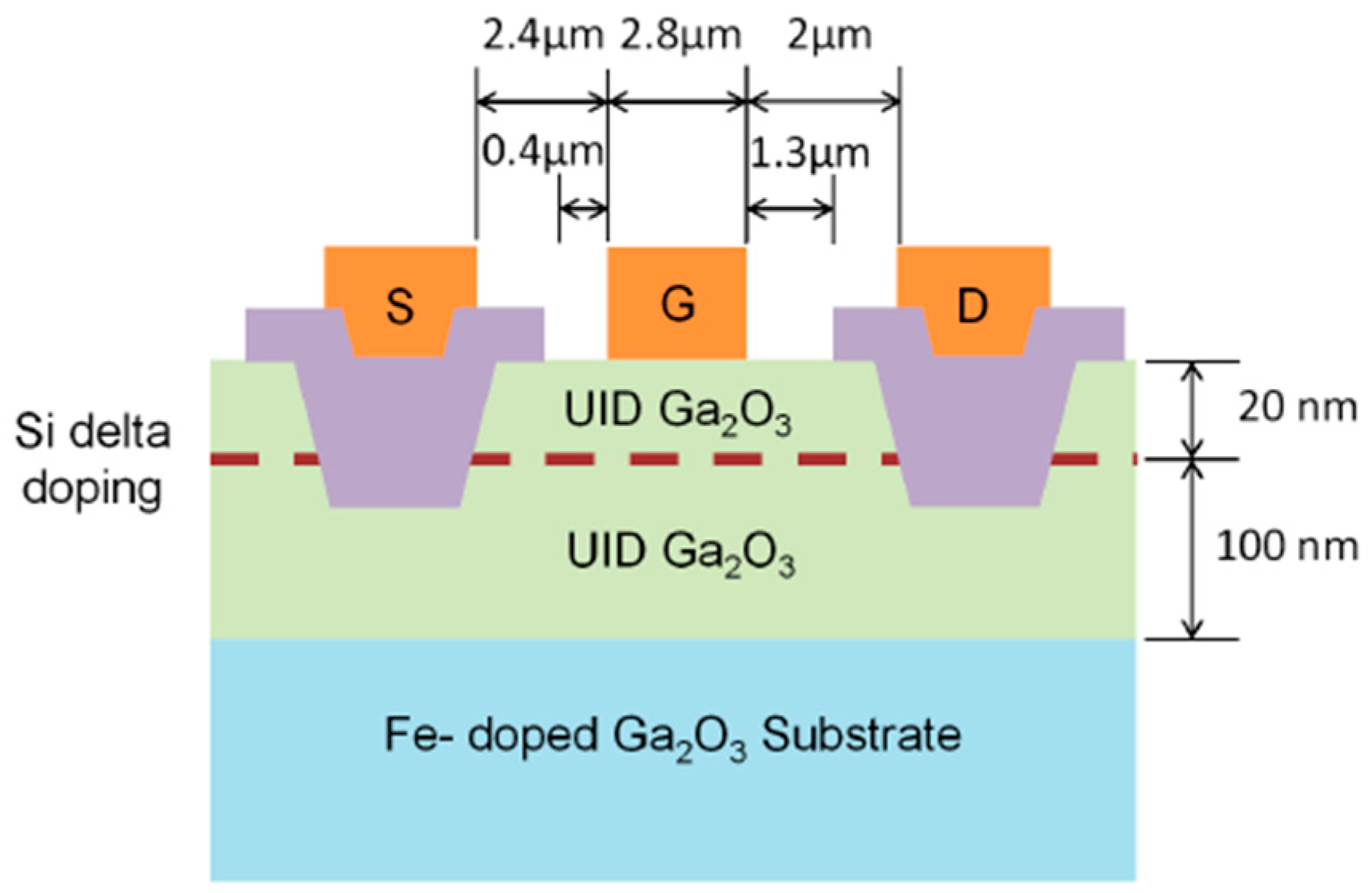

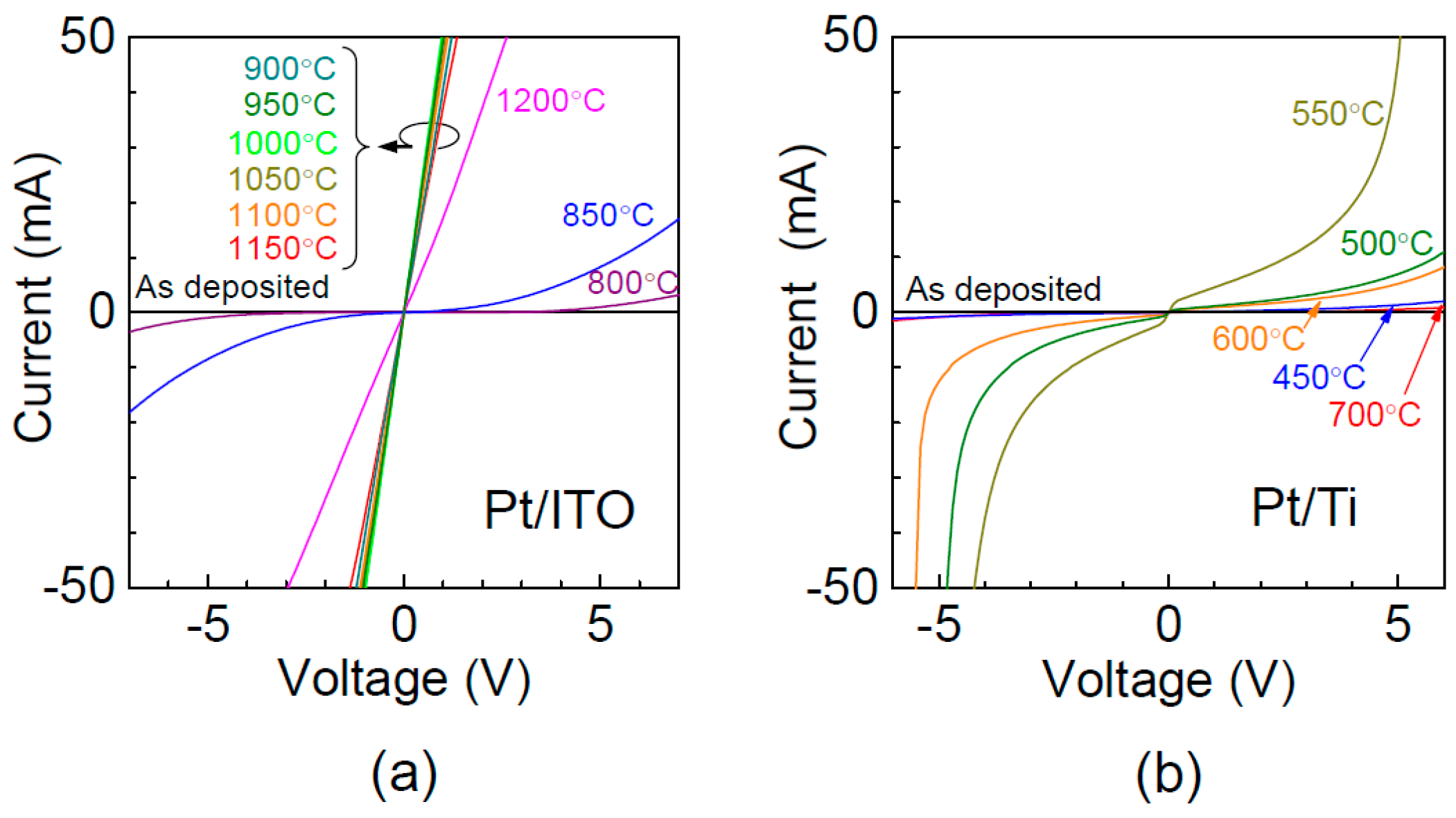
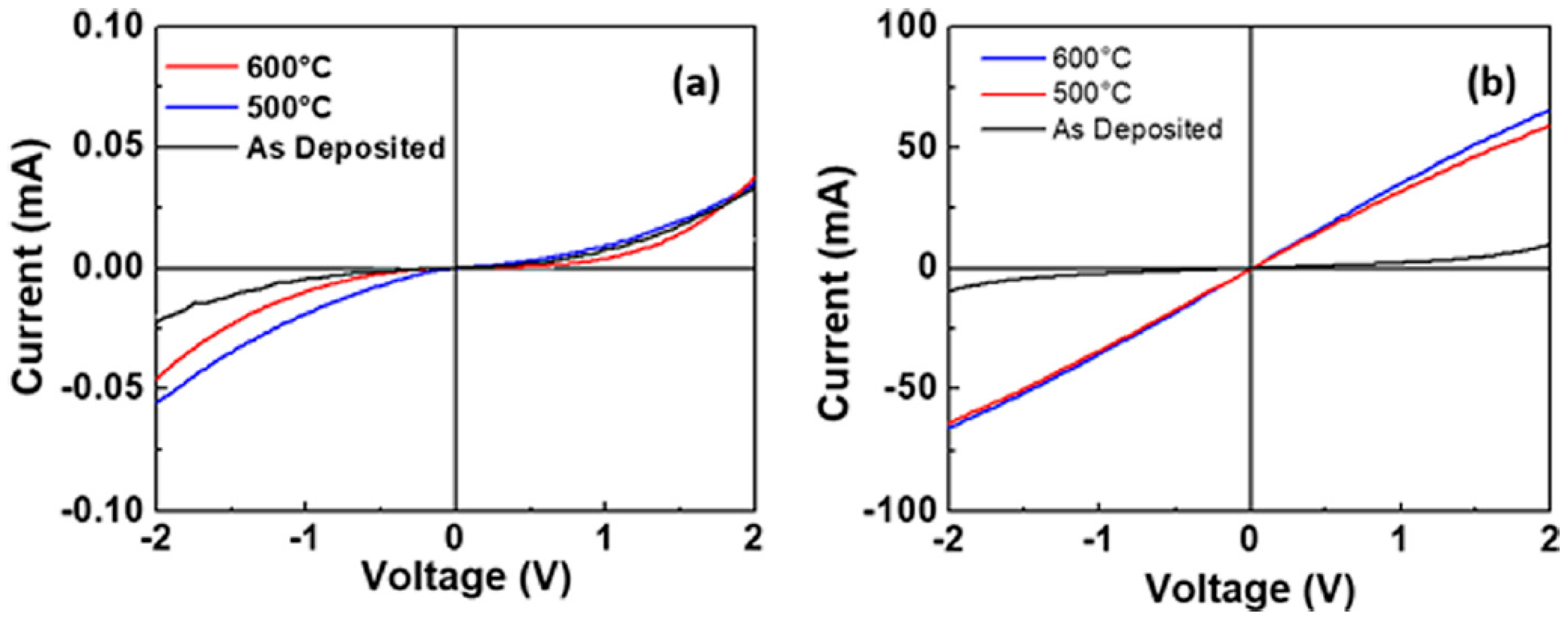



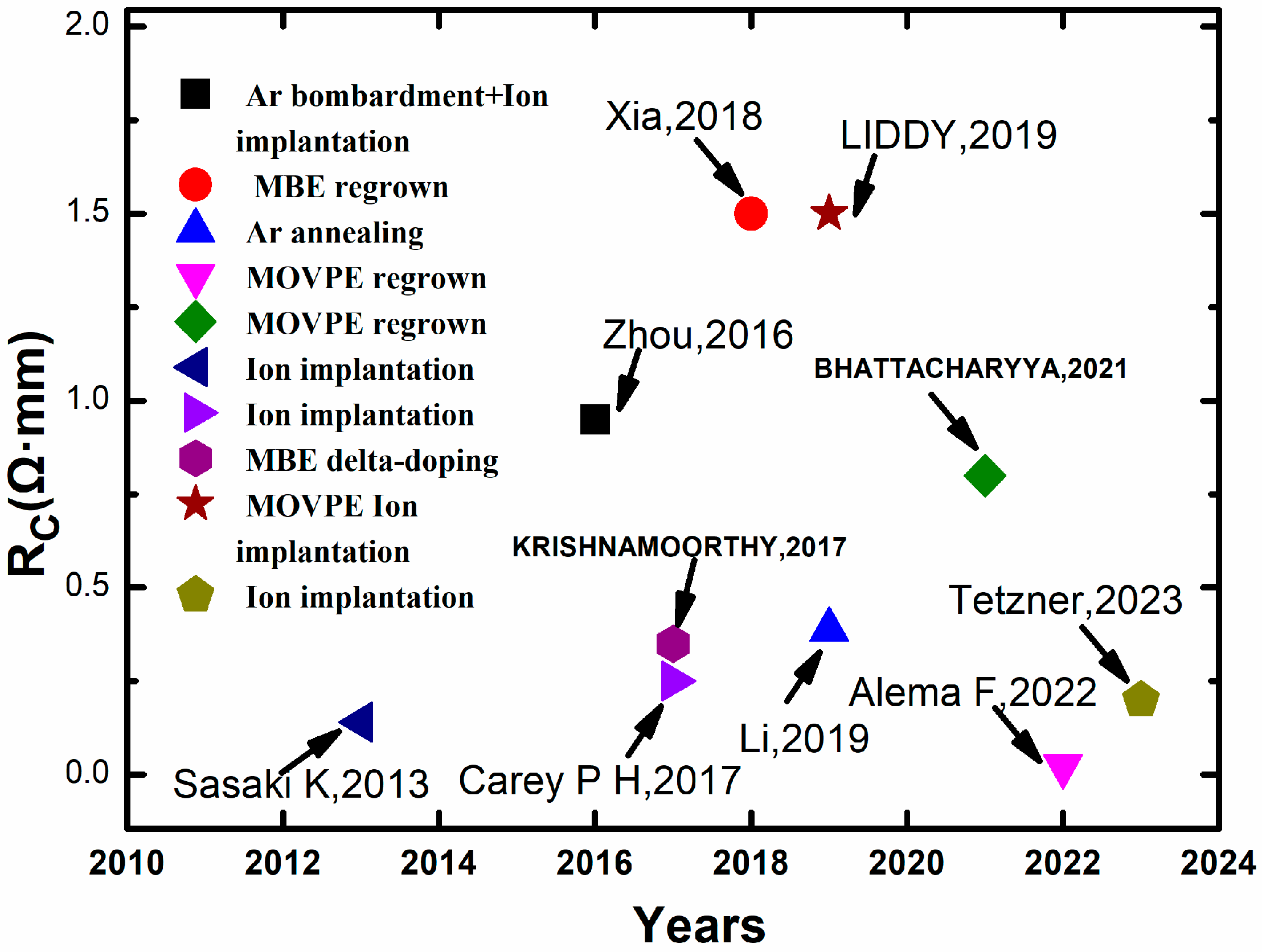
| Parameters | Si | GaAs | 4H-SiC | GaN | β-Ga2O3 |
|---|---|---|---|---|---|
| Bandgap, EG (eV) | 1.12 | 1.43 | 3.25 | 3.4 | 4.6–4.9 |
| Breakdown field, Ebr (MV/cm) | 0.3 | 0.4 | 2.5 | 3.3 | 8 |
| Electron mobility, μ (cm2 V−1 s−1) | 1480 | 8400 | 1000 | 2000 (2DEG) | 300 |
| Saturation velocity, Vs (107 cm/s) | 1 | 1.2 | 2 | 2.5 | 1.8–2 |
| BFOM, εμEbr3 | 1 | 14.7 | 317 | 846 | 2000–3000 |
| JFOM, Ebr2Vs2/(4π2) | 1 | 1.8 | 278 | 1089 | 2844 |
Disclaimer/Publisher’s Note: The statements, opinions and data contained in all publications are solely those of the individual author(s) and contributor(s) and not of MDPI and/or the editor(s). MDPI and/or the editor(s) disclaim responsibility for any injury to people or property resulting from any ideas, methods, instructions or products referred to in the content. |
© 2023 by the authors. Licensee MDPI, Basel, Switzerland. This article is an open access article distributed under the terms and conditions of the Creative Commons Attribution (CC BY) license (https://creativecommons.org/licenses/by/4.0/).
Share and Cite
Zhang, L.-Q.; Miao, W.-Q.; Wu, X.-L.; Ding, J.-Y.; Qin, S.-Y.; Liu, J.-J.; Tian, Y.-T.; Wu, Z.-Y.; Zhang, Y.; Xing, Q.; et al. Recent Progress in Source/Drain Ohmic Contact with β-Ga2O3. Inorganics 2023, 11, 397. https://doi.org/10.3390/inorganics11100397
Zhang L-Q, Miao W-Q, Wu X-L, Ding J-Y, Qin S-Y, Liu J-J, Tian Y-T, Wu Z-Y, Zhang Y, Xing Q, et al. Recent Progress in Source/Drain Ohmic Contact with β-Ga2O3. Inorganics. 2023; 11(10):397. https://doi.org/10.3390/inorganics11100397
Chicago/Turabian StyleZhang, Lin-Qing, Wan-Qing Miao, Xiao-Li Wu, Jing-Yi Ding, Shao-Yong Qin, Jia-Jia Liu, Ya-Ting Tian, Zhi-Yan Wu, Yan Zhang, Qian Xing, and et al. 2023. "Recent Progress in Source/Drain Ohmic Contact with β-Ga2O3" Inorganics 11, no. 10: 397. https://doi.org/10.3390/inorganics11100397









